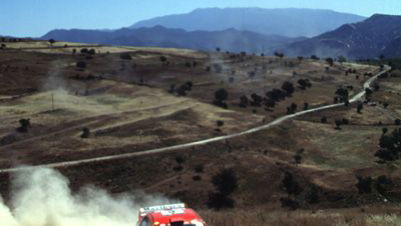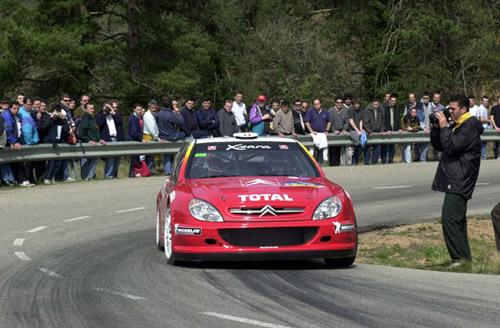Memories of Africa... by George Donaldson.
'The Safari' is like no other event in the FIA World Rally Championship. To millions of people around the world it is the ultimate rally and as legendary as the famous Rallye Monte Carlo.
In fact, what started out as a fun event for keen amateurs back in 1953 has evolved into the jewel of the sport's calendar. Some of the world's largest and most successful car manufacturers compete, but the private entrants are still there.

'The Safari' is like no other event in the FIA World Rally Championship. To millions of people around the world it is the ultimate rally and as legendary as the famous Rallye Monte Carlo.
In fact, what started out as a fun event for keen amateurs back in 1953 has evolved into the jewel of the sport's calendar. Some of the world's largest and most successful car manufacturers compete, but the private entrants are still there.
The sense of adventure and camaraderie is quite unique; few leave without a tale or two to tell, and even fewer can resist returning to a land of such rich contrasts, natural beauty and phenomenal space.
In terms of entrants and distance, the Safari Rally may be a shadow of its former self. At its peak in 1971, the year Shekhar Mehta - the current President of the Rallies Commission - finished second, a record 112 crews started and the route covered 6,400 kilometres.
Today, entries number around 55 and the distance covered is approximately 2,500 kilometres, but all the unique qualities and challenges remain.
George Donaldson, Team Manager for Marlboro Mitsubishi Ralliart, is a veteran of the Safari Rally and, even though he has travelled to some of the most spectacular and exotic countries in the world, all the superlatives come into play in his memories of Africa.
"Kenya is, without question, my favourite rally in the world," he says. "Why? The distances, the views, the fact that the cars are charging along flat out for over 100 kilometres sometimes. It's a road race basically, an absolutely fantastic thing to do. On the occasions I've had the opportunity to stand and watch the cars going across a plain for 30 or 40 kilometres, watching the helicopters above and the dust plumes... what a fantastic experience. It's the biggest show we do, lovely!
"What else...? It's hot, I like the heat, and the people are maximum friendly. I swear sometimes that I could stop at a certain place and ask myself 'where am I', and I could look round and say I could be in the Scottish highlands! A wee while later I could be in Finland and then I'm in the jungle with Tarzan and Jane just up the road! And where else can you stand four kilometres from the Equator and be on a glacier?
"The history of the place is amazing. When the first people trekked through Africa and reported back to the National Geographic Society in London that, just five days walk from the coast and so close to the Equator, there was a snow-covered mountain, an extinct volcano, that had to be 50 miles across and 19,000 feet high. The guy was laughed out of the Society, but it's there.
"My first visit to Kenya was in 1986 and I was there for seven weeks for the testing, recce and rally. In the last 15 years I would say I've spent maybe three in Kenya. I've got lots of good friends there, people like Ian Duncan who's been a very good friend over the years, Shekhar (Mehta) who's originally from Africa, Mike Kirkland, Robin Ulyate, Ian Kelsall, Ivan Smith, former Clerks of the Course, Mike Doughty, Peter and his son Mike Hughes, Nick Thurie, the press officer for so many years. They and many others, they're all fantastic. The workshop staff I have employed locally, Isaac Aseki. There are waiters in restaurants I've gone to for the past 15 years, John Mwangi in my favourite Chinese! And the doormen in hotels, the staff at the Serena Hotel where I've stayed on and off for those 15 years. The welcome is incredible, and there's nothing like it anywhere else.
"I'd been to the Ivory Coast before, but I'll never forget my first impressions when I arrived in Kenya in 1986. I was collected from the airport and going straight to the workshop, but to see African women working in the fields by the side of the road with children tied to their backs, using hand hoes that could've been used 2000 years ago, was unreal, a big culture shock.
"Over the years you certainly learn to understand the cultural differences and the limit of what you, as an individual, can do. You learn to deal with the difficulties of Africa and have big contingency plans for everything. Just getting our freight from Mombassa used to be a logistical nightmare.
"The railway was always very unreliable so in the end we used to drive all the containers up to Nairobi, it was a serious convoy and dangerous, but if everything was on the train and it broke down it could take weeks to get fixed.
"One year I remember persuading our engineers that it was a complete waste of time to take a helicopter out to find the train which was stuck somewhere like Mtito Andei (great names as well!). He reckoned he could get some trucks down there, with the customs people, and off-load everything in the middle of no where.
"It just doesn't work like that, you can't ride roughshod over the local procedures in Africa just because their systems are different to ours. It's all about cultural differences, and that's what makes life so rich and colourful.
"I've seen bad things in Kenya as well, things that are possibly borne from a lack of understanding. I stood and watched the Lancia helicopter go down; the tail lifted and the nose went in and there was a complete loss of power and it crashed. But amazingly I then witnessed the mechanics running away from the wreckage towards the rally car with their toolboxes. Unbelievable!
"I've been in a comms aircraft taking off from Eldoret Aerodrome that's had to seriously bank left and right to get through a 50 metre gap between trees 500 metres after takeoff because it could not climb away, that was frightening. The gap was only there because of an aircraft crashing there a few weeks earlier... It then took us five minutes to make 1000 feet, we just couldn't get the altitude with too much fuel at the wrong time of time of day.
"Taking off from Lake Baringo in a light twin-engine aircraft, we picked up most of the bushes on the undercarriage and the props were chopping through the trees! How it still flew... I don't know.
"This rally's slightly later in the season this year, hopefully to avoid some of the really wet weather we've had in the past. We'll see, I think the climate's changing everywhere around the world and these days you can have a rough idea of what to expect, but nothing's guaranteed.
"As a team we're obviously looking for a good run. The Mitsubishi is strong and reliable and I don't really see any reason why either Tommi or Freddy can't pull something special out of the bag. Sure, the competition is strong, but this is a very tactical rally that has to be driven with your head, not your foot.
"Okay, Freddy doesn't possibly have the best memories - although he's not one to dwell on such things - but Tommi's won with Mitsubishi in the past and obviously knows how to win this rally. I think for any driver to be able to say they've won the Safari is a massive achievement and it would be great to think the Marlboro Mitsubishi Ralliart guys could be at the centre of what is always a 'memorable' victory party in Kenya..."


